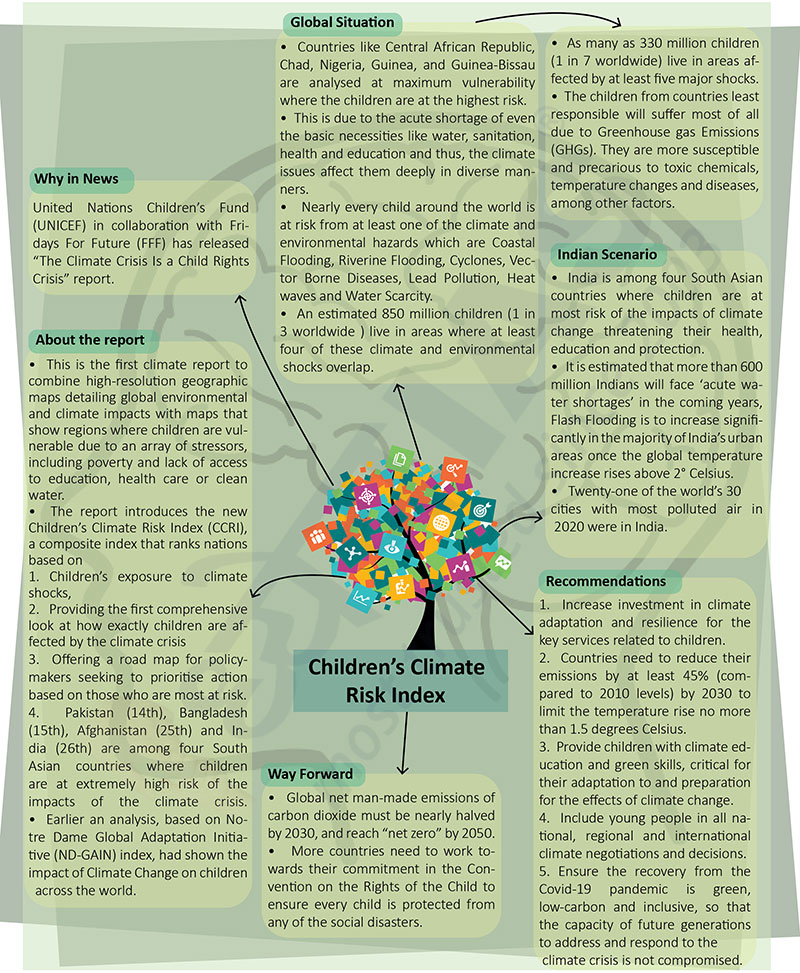Brain-booster /
29 Dec 2021
Brain Booster for UPSC & State PCS Examination (Topic: Children’s Climate Risk Index)

Why in News?
- United Nations Children’s Fund (UNICEF) in collaboration with Fridays
For Future (FFF) has released “The Climate Crisis Is a Child Rights Crisis”
report.
About the report
- This is the first climate report to combine high-resolution geographic
maps detailing global environmental and climate impacts with maps that show
regions where children are vulnerable due to an array of stressors,
including poverty and lack of access to education, health care or clean
water.
- The report introduces the new Children’s Climate Risk Index (CCRI), a
composite index that ranks nations based on
- Children’s exposure to climate shocks,
- Providing the first comprehensive look at how exactly children are
affected by the climate crisis
- Offering a road map for policymakers seeking to prioritise action
based on those who are most at risk.
- Pakistan (14th), Bangladesh (15th), Afghanistan (25th) and India
(26th) are among four South Asian countries where children are at
extremely high risk of the impacts of the climate crisis.
- Earlier an analysis, based on Notre Dame Global Adaptation Initiative
(ND-GAIN) index, had shown the impact of Climate Change on children across
the world.
Global Situation
- Countries like Central African Republic, Chad, Nigeria, Guinea, and
Guinea-Bissau are analysed at maximum vulnerability where the children are
at the highest risk.
- This is due to the acute shortage of even the basic necessities like
water, sanitation, health and education and thus, the climate issues affect
them deeply in diverse manners.
- Nearly every child around the world is at risk from at least one of the
climate and environmental hazards which are Coastal Flooding, Riverine
Flooding, Cyclones, Vector Borne Diseases, Lead Pollution, Heat
waves and Water Scarcity.
- An estimated 850 million children (1 in 3 worldwide ) live in areas
where at least four of these climate and environmental shocks overlap.
- As many as 330 million children (1 in 7 worldwide) live in areas
affected by at least five major shocks.
- The children from countries least responsible will suffer most of all
due to Greenhouse gas Emissions (GHGs). They are more susceptible and
precarious to toxic chemicals, temperature changes and diseases, among other
factors.
Indian Scenario
- India is among four South Asian countries where children are at most
risk of the impacts of climate change threatening their health, education
and protection.
- It is estimated that more than 600 million Indians will face ‘acute
water shortages’ in the coming years, Flash Flooding is to increase
significantly in the majority of India’s urban areas once the global
temperature increase rises above 2° Celsius.
- Twenty-one of the world’s 30 cities with most polluted air in 2020 were
in India.
Recommendations
- Increase investment in climate adaptation and resilience for the key
services related to children.
- Countries need to reduce their emissions by at least 45% (compared to
2010 levels) by 2030 to limit the temperature rise no more than 1.5 degrees
Celsius.
- Provide children with climate education and green skills, critical for
their adaptation to and preparation for the effects of climate change.
- Include young people in all national, regional and international climate
negotiations and decisions.
- Ensure the recovery from the Covid-19 pandemic is green, low-carbon and
inclusive, so that the capacity of future generations to address and respond
to the climate crisis is not compromised.
Way Forward
- Global net man-made emissions of carbon dioxide must be nearly halved by
2030, and reach “net zero” by 2050.
- More countries need to work towards their commitment in the Convention
on the Rights of the Child to ensure every child is protected from any of
the social disasters.









